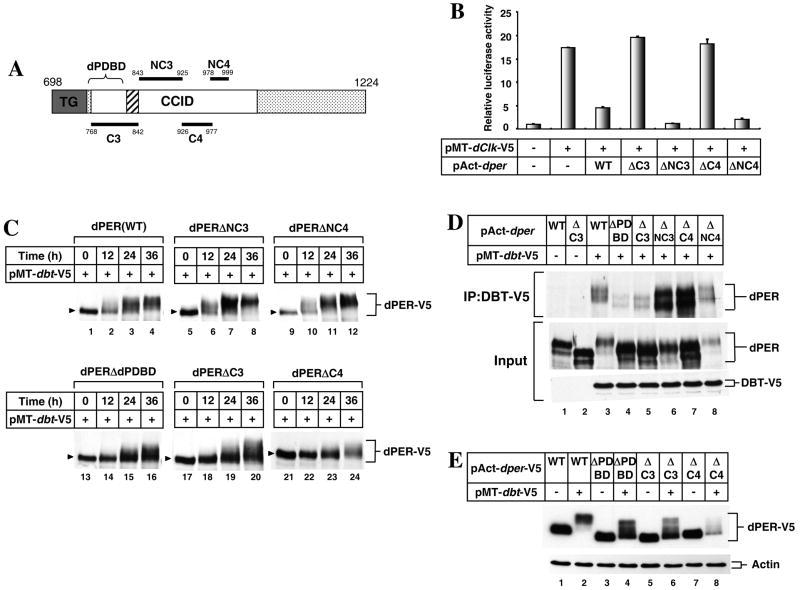Figure 1.
dPER(ΔC4) is defective in transcriptional repression and DBT-dependent progressive phosphorylation in S2 cells. (A) Schematic diagram of functional domains in the C-terminal half of dPER protein (accession no. P07633). Horizontal lines denote regions internally deleted from full length dPER to generate mutants analyzed in this study. Domains are as follows: Thr-Gly repeats (dark grey box with letter “TG”); dCLK:CYC inhibitory domain (CCID; aa 764 to 1034; white box) (Chang and Reppert, 2003); dPER DBT Binding Domain (dPDBD; aa 755 to 809; bracket) (Kim et al., 2007); putative nuclear localization sequence (aa 813 to 840, hatched box) (Chang and Reppert, 2003). (B) S2 cells were transiently transfected in the presence (+) or absence of (-) pMT-dClk-V5. In addition, some cells were co-transfected with different versions of pAct-dper, as indicated. Shown are the average values from three independent experiments for relative luciferase activity. Luc activity in the absence of pMT-dClk-V5 was set to 1, and all other values were normalized. (C -E) S2 cells were transiently transfected with different versions of V5-tagged pAct-dper (C, E) or non-tagged pAct-dper (D), as indicated (top of panels). In addition, some cells were co-transfected with pMT-dbt-V5, as indicated (+). Exogenous DBT was induced 36 hr after transfection by adding 500 μM CuSO4 to the medium. Cells were harvested at the indicated times (C), 24 hr (D), or 36 hr (E) after induction, and protein extracts were either directly analyzed by immunoblotting (C - E) or first subjected to immunoprecipitation in the presence of anti-V5 antibodies (D, top panel). Arrowheads indicate hypo-phosphorylated isoforms in each variants of dPER. (D) ‘Input’ indicates protein lysates used for immunoprecipitation. dPER was visualized with anti-dPER antibodies, whereas recombinant DBT with anti-V5 antibodies.

